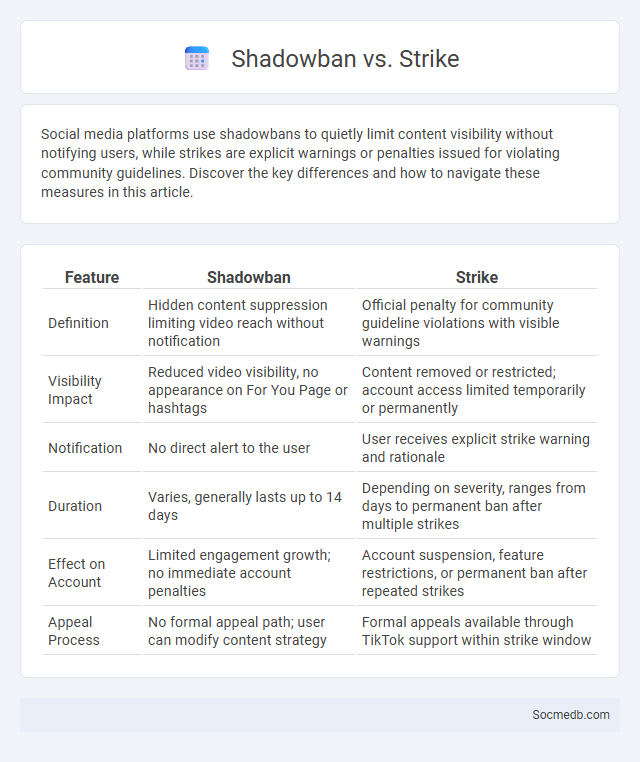
Photo illustration: Shadowban vs Strike
Social media platforms use shadowbans to quietly limit content visibility without notifying users, while strikes are explicit warnings or penalties issued for violating community guidelines. Discover the key differences and how to navigate these measures in this article.
Table of Comparison
| Feature | Shadowban | Strike |
|---|---|---|
| Definition | Hidden content suppression limiting video reach without notification | Official penalty for community guideline violations with visible warnings |
| Visibility Impact | Reduced video visibility, no appearance on For You Page or hashtags | Content removed or restricted; account access limited temporarily or permanently |
| Notification | No direct alert to the user | User receives explicit strike warning and rationale |
| Duration | Varies, generally lasts up to 14 days | Depending on severity, ranges from days to permanent ban after multiple strikes |
| Effect on Account | Limited engagement growth; no immediate account penalties | Account suspension, feature restrictions, or permanent ban after repeated strikes |
| Appeal Process | No formal appeal path; user can modify content strategy | Formal appeals available through TikTok support within strike window |
Understanding Shadowban: Definition and Impact
Shadowban is a covert restriction imposed by social media platforms that limits the visibility of your content without notifying you, resulting in decreased engagement and reach. This practice often targets users who violate community guidelines or exhibit spam-like behavior, making your posts less discoverable in feeds and search results. Recognizing the signs of a shadowban can help you adjust your content strategy to regain visibility and maintain your online presence.
What is a Strike? Platform Enforcement Explained
A strike on social media platforms is a penalty issued for violating community guidelines or terms of service, often resulting in temporary restrictions or account suspension. Platforms like YouTube, Instagram, and TikTok use strike systems to enforce rules, with strikes accumulating to escalate consequences. Understanding strike policies helps users avoid content removal, demonetization, and potential bans, ensuring compliance with platform standards.
Shadowbanning: Mechanisms and Detection
Shadowbanning occurs when social media platforms limit the visibility of Your posts without notification, often through algorithmic filtering or account restrictions. This covert moderation mechanism reduces engagement by hiding content from follower feeds, search results, or hashtags, making detection challenging for users. Tools and techniques such as monitoring sudden drops in interaction metrics and using third-party analytics can help identify potential shadowban effects.
Key Differences: Shadowban vs Strike
Shadowban limits your content visibility by making it less discoverable without direct notification, causing reduced engagement and reach. Strikes are formal violations reported by the platform, often leading to explicit warnings, temporary restrictions, or account suspension. Understanding these key differences helps you navigate social media policies effectively and maintain your online presence.
Common Reasons for Receiving a Shadowban
Common reasons for receiving a shadowban on social media include engaging in repetitive or spammy behavior such as excessive liking, commenting, or following within a short period. Using inappropriate or banned hashtags and sharing content that violates platform guidelines, including misinformation or harmful material, significantly increases the risk. Accounts flagged for automated activity or reported by other users for harassment or policy violations often face shadowbans to limit their visibility and enforce community standards.
When Do Platforms Use Strikes Instead of Shadowbans?
Social media platforms use strikes instead of shadowbans when content violations are clear and documented, allowing users to receive formal warnings or penalties. Strikes are often part of a tiered enforcement system, where repeated offenses can lead to account suspensions or bans, promoting transparency in content moderation. Shadowbans, in contrast, are used for subtler suppression, usually without notifying the user, targeting spammy or borderline content to reduce visibility without direct confrontation.
Effects of Shadowbanning on User Engagement
Shadowbanning reduces user visibility on social media platforms, significantly decreasing engagement metrics such as likes, comments, and shares. Users affected by shadowbanning often experience a decline in follower growth and overall interaction rates, leading to diminished content reach. This covert restriction undermines community building and content dissemination, negatively impacting user motivation and platform activity.
How to Identify If You’ve Been Shadowbanned
Shadowbanning on social media can be identified by a drastic drop in your engagement rates, such as fewer likes, comments, or views compared to your usual performance. You may notice your posts not appearing in hashtags or searches, indicating restricted visibility without direct notification from the platform. Checking your account's reach analytics and conducting external searches for your username can help confirm if your content is being shadowbanned.
Preventing Strikes and Shadowbans: Best Practices
Preventing strikes and shadowbans on social media requires careful adherence to platform guidelines, including avoiding spammy behavior and respecting community standards. You should regularly review and update your content to ensure compliance with evolving policies, using analytics tools to monitor engagement and detect potential issues early. Prioritizing authentic interactions and transparent communication helps maintain your account's health and guard against penalties.
Navigating Appeals: Recovering From a Shadowban or Strike
Recovering from a social media shadowban or strike requires understanding platform-specific community guidelines and appeal procedures to restore account visibility and engagement. Users should gather evidence of compliant content while addressing any content violations directly through official appeal channels. Consistent, policy-aligned postings combined with user feedback can accelerate the reinstatement of normal account functions, minimizing long-term impact on reach and follower interaction.
 socmedb.com
socmedb.com